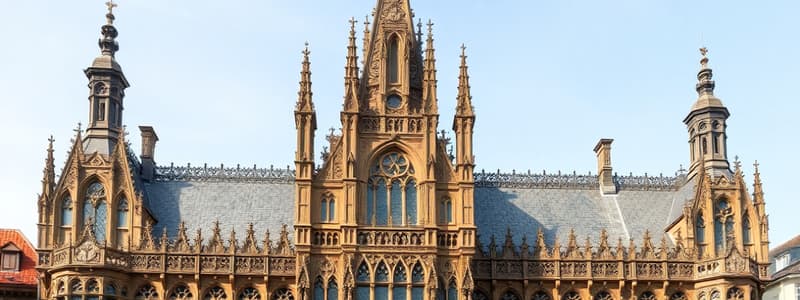Podcast
Questions and Answers
What was a major factor contributing to the rise of 'art architects' after 1850?
What was a major factor contributing to the rise of 'art architects' after 1850?
- Increased investment in public infrastructure projects
- The growing influence of industrial design on architectural aesthetics
- The availability of cheaper materials and construction techniques
- The increasing wealth and patronage of the upper class (correct)
How did the rise of 'art architects' impact the traditional role of the 'professional architect'?
How did the rise of 'art architects' impact the traditional role of the 'professional architect'?
- It resulted in a decline in the number of professional architects as the art architect movement gained popularity
- It encouraged professional architects to incorporate more artistic elements into their work.
- It led to a re-evaluation of the importance of practical skills over artistic talent
- It created a divide between those focused on commercial building and those prioritizing artistic expression (correct)
What is the main takeaway from the example of W.W. Pocock and his son Maurice Pocock?
What is the main takeaway from the example of W.W. Pocock and his son Maurice Pocock?
- The impact of technological advancements on architectural practices
- The shift from a commercially focused approach to one that valued artistic expression (correct)
- The tension between father and son in the field of architecture
- The importance of formal education in shaping architectural styles.
What role did the Gothic Revival and the church building movement play in the development of art architecture?
What role did the Gothic Revival and the church building movement play in the development of art architecture?
What can be inferred about the role of the Royal Institute of British Architects (RIBA) and architectural magazines in this period?
What can be inferred about the role of the Royal Institute of British Architects (RIBA) and architectural magazines in this period?
Which of the following accurately reflects the impact of the Arts and Crafts movement on architectural practices?
Which of the following accurately reflects the impact of the Arts and Crafts movement on architectural practices?
The emergence of "professional architects" in the mid-19th century was primarily driven by:
The emergence of "professional architects" in the mid-19th century was primarily driven by:
Which of the following BEST exemplifies the tension between artistic ideals and practical considerations in British architecture?
Which of the following BEST exemplifies the tension between artistic ideals and practical considerations in British architecture?
The registration debates among architects, culminating in the 1931 law, ultimately served to:
The registration debates among architects, culminating in the 1931 law, ultimately served to:
Which of the following statements accurately represents the impact of Pugin's influence on architecture?
Which of the following statements accurately represents the impact of Pugin's influence on architecture?
Which of the following best describes the contribution of Lethaby and Fleming to reforming architectural education?
Which of the following best describes the contribution of Lethaby and Fleming to reforming architectural education?
The historical tension between "art architects" and "professional architects" serves as a reminder that:
The historical tension between "art architects" and "professional architects" serves as a reminder that:
Considering the challenges of balancing artistic ideals with practical needs in modern architecture, what's a crucial consideration at Cambridge for supervisors?
Considering the challenges of balancing artistic ideals with practical needs in modern architecture, what's a crucial consideration at Cambridge for supervisors?
What was the main argument in the book 'Architecture a Profession or an Art' (1892)?
What was the main argument in the book 'Architecture a Profession or an Art' (1892)?
Which of the following architects supported the idea of architectural registration?
Which of the following architects supported the idea of architectural registration?
Which of the following architects was a prominent member of the Arts and Crafts movement?
Which of the following architects was a prominent member of the Arts and Crafts movement?
What was the main reason for the delay in architectural registration in Britain?
What was the main reason for the delay in architectural registration in Britain?
What was the main development in architecture that prompted a shift toward a more professionalized approach in the second half of the 19th century?
What was the main development in architecture that prompted a shift toward a more professionalized approach in the second half of the 19th century?
Why did some architects in the latter half of the 19th century attribute the profession's newfound security to the concept of art?
Why did some architects in the latter half of the 19th century attribute the profession's newfound security to the concept of art?
How did building regulations contribute to the professionalization of architecture?
How did building regulations contribute to the professionalization of architecture?
What was the main criticism of the book 'Architecture a Profession or an Art'?
What was the main criticism of the book 'Architecture a Profession or an Art'?
Which of the following architects supported the idea of a 'revitalized crafts process'?
Which of the following architects supported the idea of a 'revitalized crafts process'?
What was the main reason for the rise of architectural specialization in the mid-19th century?
What was the main reason for the rise of architectural specialization in the mid-19th century?
How did the rise of building regulations affect the role of architects?
How did the rise of building regulations affect the role of architects?
How did architects during the 19th century attempt to protect the public from 'bad architecture'?
How did architects during the 19th century attempt to protect the public from 'bad architecture'?
What was the impact of the Arts and Crafts movement on the professionalization of architecture?
What was the impact of the Arts and Crafts movement on the professionalization of architecture?
How did architects who supported the arts and crafts movement view the idea of architectural registration?
How did architects who supported the arts and crafts movement view the idea of architectural registration?
What was the main reason why British architectural elites in the first half of the 20th century continued to prioritize art over efficiency in their work?
What was the main reason why British architectural elites in the first half of the 20th century continued to prioritize art over efficiency in their work?
Flashcards
Artistic Opportunities Post-1850
Artistic Opportunities Post-1850
The increase in private wealth allowed artists to pursue their own styles and educational benefits.
Old-fashioned vs. Art Architect
Old-fashioned vs. Art Architect
Conflict arose between traditional architects and those focused on artistic integrity.
W.W. Pocock
W.W. Pocock
A London architect known for commercial work with limited artistic vision, contrasting with his son.
Maurice Pocock
Maurice Pocock
Signup and view all the flashcards
Gothic Revival Influence
Gothic Revival Influence
Signup and view all the flashcards
Post-1850 Architectural Shift
Post-1850 Architectural Shift
Signup and view all the flashcards
Professional vs Art Architects
Professional vs Art Architects
Signup and view all the flashcards
Gothic Revival Era
Gothic Revival Era
Signup and view all the flashcards
Arts and Crafts Movement
Arts and Crafts Movement
Signup and view all the flashcards
RIBA's Role
RIBA's Role
Signup and view all the flashcards
Registration Debates
Registration Debates
Signup and view all the flashcards
Pugin's Influence
Pugin's Influence
Signup and view all the flashcards
Edwardian Reforms
Edwardian Reforms
Signup and view all the flashcards
Burn's Publication Reluctance
Burn's Publication Reluctance
Signup and view all the flashcards
Architecture a Profession or an Art (1892)
Architecture a Profession or an Art (1892)
Signup and view all the flashcards
Society of Architects (1884)
Society of Architects (1884)
Signup and view all the flashcards
Kerr's Textbook
Kerr's Textbook
Signup and view all the flashcards
Ruskin's Influence
Ruskin's Influence
Signup and view all the flashcards
Architects' Autonomy Decline
Architects' Autonomy Decline
Signup and view all the flashcards
Pugin's Craft Focus
Pugin's Craft Focus
Signup and view all the flashcards
Building Regulations Growth
Building Regulations Growth
Signup and view all the flashcards
Architectural Education Changes
Architectural Education Changes
Signup and view all the flashcards
Complex Building Types Explosion
Complex Building Types Explosion
Signup and view all the flashcards
Art vs. Professionalism
Art vs. Professionalism
Signup and view all the flashcards
Public Awareness of Bad Architecture
Public Awareness of Bad Architecture
Signup and view all the flashcards
Importance of Efficiency
Importance of Efficiency
Signup and view all the flashcards
Study Notes
Architectural Evolution in 19th-Century Britain
-
Post-1850 Wealth and Artistic Opportunities: Increased private wealth fostered artistic freedom and specialized architectural practices. Architects could prioritize aesthetic ideals over strict commercial constraints.
-
Rise of "Art Architects": A growing divide emerged between traditional "professional architects" and new "art architects". This split often involved differing opinions regarding the value of art and design.
-
Gothic Revival and Architectural Magazines: The Gothic Revival movement fueled debates, with figures like Scott, Street, and Burges promoting this architectural style. Architectural magazines became outlets for discussion.
-
Shift in Domestic Architecture: After 1875, domestic architecture solidified in Britain, with established country house architects experiencing reduced need for publicity. Architectural magazines' influence on client relationships became apparent.
Professionalization and Registration Debates
-
RIBA and the Profession: The Royal Institute of British Architects (RIBA) played a central role in professionalization, but faced clashes over artistic autonomy.
-
Burn, Shaw, and the 1892 Manifesto: Figures like Burn and Shaw challenged RIBA's influence and advocated for artistic integrity in architecture. The "Architecture a Profession or an Art" manifesto reflected these concerns.
-
Registration and Education: Debates over architectural registration led to increased emphasis on organized education, creating structured qualifications. Initial resistance to registration eventually gave way to a mandatory system.
-
Arts and Crafts Movement: The arts and crafts movement influenced the discussion, emphasizing craftsmanship and opposing the perceived fragmentation of building practices from the formal architectural practice.
-
Architects' Control over Crafts: By the 1890s, architects often held significant control over artistic decisions, often overshadowing artisans.
Protecting the Public from Bad Architecture
-
Edwardian Educational Reforms: Educational reforms in the Edwardian period established architecture schools, but the integration of design concerns remained limited.
-
Balancing Art & Efficiency: Historical British architectural practice tended to prioritize artistic vision over efficiency concerns.
-
Supervision Considerations at Cambridge: The historical context of architectural evolution—conflict between art and professional practice—continues to inform contemporary building practices for projects at Cambridge.
Context of Architectural Evolution
-
Economic & Social Context: Economic growth, wealth diffusion, and increasing city populations fueled the growth of advanced building types requiring specialized architecture.
-
Specialized Practices: Specialized architectural practices addressing the complexity of building types (e.g., hotels, schools, libraries) emerged.
-
Building Regulations: Growing building regulations created a need for educated intermediaries (architects) within the client-contractor-bureaucracy process.
Studying That Suits You
Use AI to generate personalized quizzes and flashcards to suit your learning preferences.




